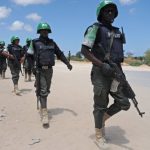Araweelo News Network

AMISOM soldiers patrol in the Somali capital Mogadishu, April 12, 2015. The 22,000-strong force plays a crucial role in maintaining security in Somalia, in the face of a looming threat from Al-Shabab.Mohamed Abdiwahab/AFP/Getty Images
Mugadishu(ANN)Somalia’s modern history is a tale of independence, prosperity and democracy in the 1960s, military dictatorship in the 1970s and 1980s – followed by a desperate decline into civil war and chaos almost ever since.
The effect of the war has been to scatter the Somali people in their millions to refugee camps and neighbouring countries – and in their hundreds of thousands to the UK, Canada and the United States.
Somalia gained independence from Britain, France and Italy in 1960. It held free and fair elections and was ruled democratically from 1960 to 1969.
Somalia has become a kind of catchword for a kind of violent, terrible situation.
Mary Harper, Africa Editor, BBC
Once labelled the “Switzerland of Africa”, Somalia enjoyed almost a decade of democracy. The first elected president of Somalia, uniting the former British and Italian territories, was Adam Abdullah Osman who reigned for seven years. He was succeeded, freely and peacefully, by Abdirashid Ali Sharmarke.
Sharmarke, however, was assassinated by one of his own bodyguards in 1969.
Prime Minister Mukhtar Mohamed Hussein took over, but his brief, six-day tenure was cut short by a military coup led by General Siad Barre, ending Somalia’s period of democratic government.
Whatever its faults – and there were many – Barre’s 22-year rule effectively created modern Somalia, building one of Africa’s strongest armies and massively improving the literacy of the population.
Yet Barre, who gained the support of the US and the Soviet Union, the superpowers of the day, also dissolved parliament, suspended the constitution, banned political parties, arrested politicians and curbed press freedom.
“From then, there was a downward trend. In everything. A disintegration. And every time things were going down, the military regime was becoming more brutal and more dictatorial,” says Jama Mohamed Ghalib, a former Somali government minister.
But when Barre launched the Ogaden war in 1977 to take the Somali majority region from Ethiopia, it provoked serious international opposition, including that of the Soviet Union which had once supported Barre but now sided with Ethiopia. The Somali army was forced to withdraw.
Opposition to the Barre government gradually increased and in May 1988, encouraged by Ethiopia, the same northern tribes – in what had once been British Somalia – rebelled against Barre’s dictatorship. This provoked the full force of his military power and aggression and thousands of northern Somalis were killed.
Three years later, in 1991, both the northern and southern tribes, again supported by Ethiopia, rose up against Barre. His grip on power had weakened, his former allies had abandoned him and he was finally brought down. One outcome was the northern region proclaiming its independence and declaring itself as Somaliland. It maintains its separatism today, but has hardly any international recognition.
But the other long-lasting outcome was civil war, with myriad competing factions and frequent intervention by foreign powers and neighbouring countries. In 2006, the Islamic Courts Union split into several factions, one of which was Al Shabab. The radical group still controls large parts of the south of the country today.
“If Siad Barre was to leave power two years earlier and said, ‘Now, Somalis, you have to organise new elections and I will be happy to leave’ – none of this would have happened. But when he brutalised different groups of people in different regions of the country, people were just, literally, mindlessly trying to get rid of him,” says Abdi Samatar, professor of geography at the University of Minnesota.
A flood of UN aid in the 1990s and 2000s led to the collapse of Somali agriculture and has reduced many farmers to poverty. At the same time, fishing by large foreign vessels in Somali waters has led to the piracy off the coast which has become synonymous in many people’s minds with Somalia worldwide.
Source: Al Jazeera




